Community wells can pose significant challenges, especially during droughts when shallow wells may run dry, leading to competition for limited resources. That’s why efficient rainwater harvesting and stormwater management are essential solutions. Installing rain tanks that prevent overflow when full is a smart way to conserve water and ensure availability during dry periods. Proper maintenance and repair are also important considerations—annual costs for community systems average $1,000, with repairs adding an extra $700. Planning for long-term water sustainability may seem complex, but with the right practices, it’s easier than you think. By understanding and adopting effective water management strategies, you can ensure a reliable, sustainable water supply for your community.
Our forward-thinking customer is planning ahead, tapping into an often-overlooked resource right above our heads. By implementing a robust rainwater collection system, they’re securing a long-term solution that’s both eco-friendly and cost-effective. 🏡💚Here’s what makes this setup a game-changer:
This impressive system isn’t just a water solution – it’s a smart hedge against future uncertainties. By thinking outside the tap, our customer is taking control of their water supply and reducing dependence on community wells. 💪
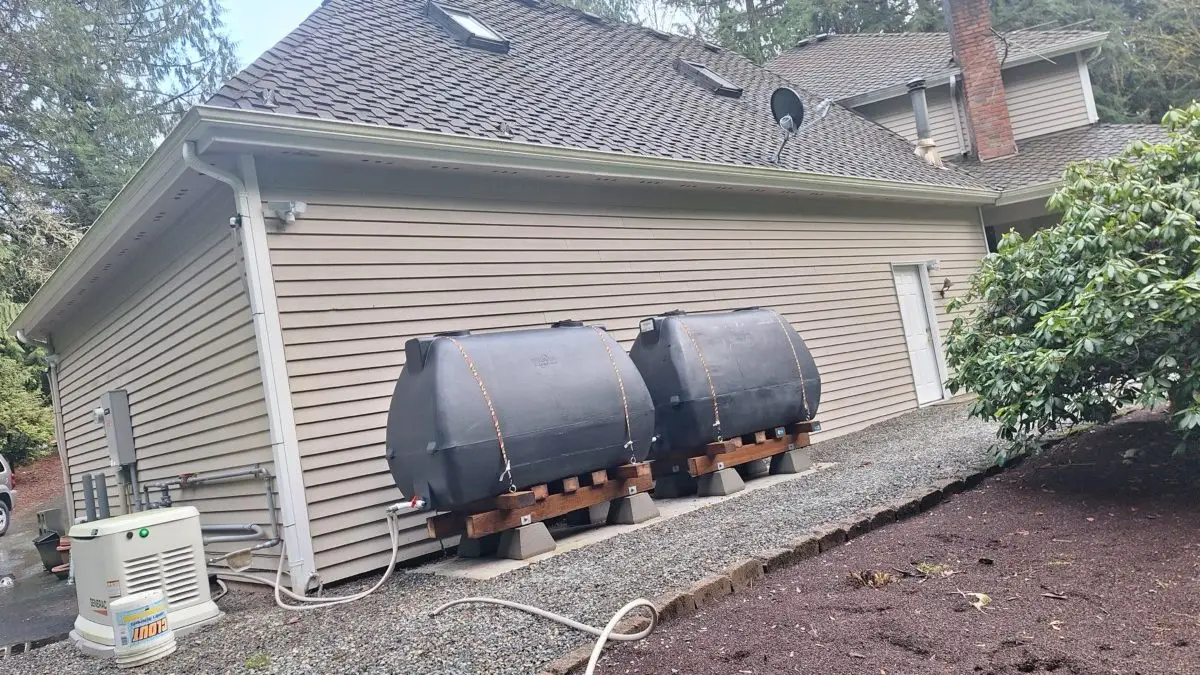
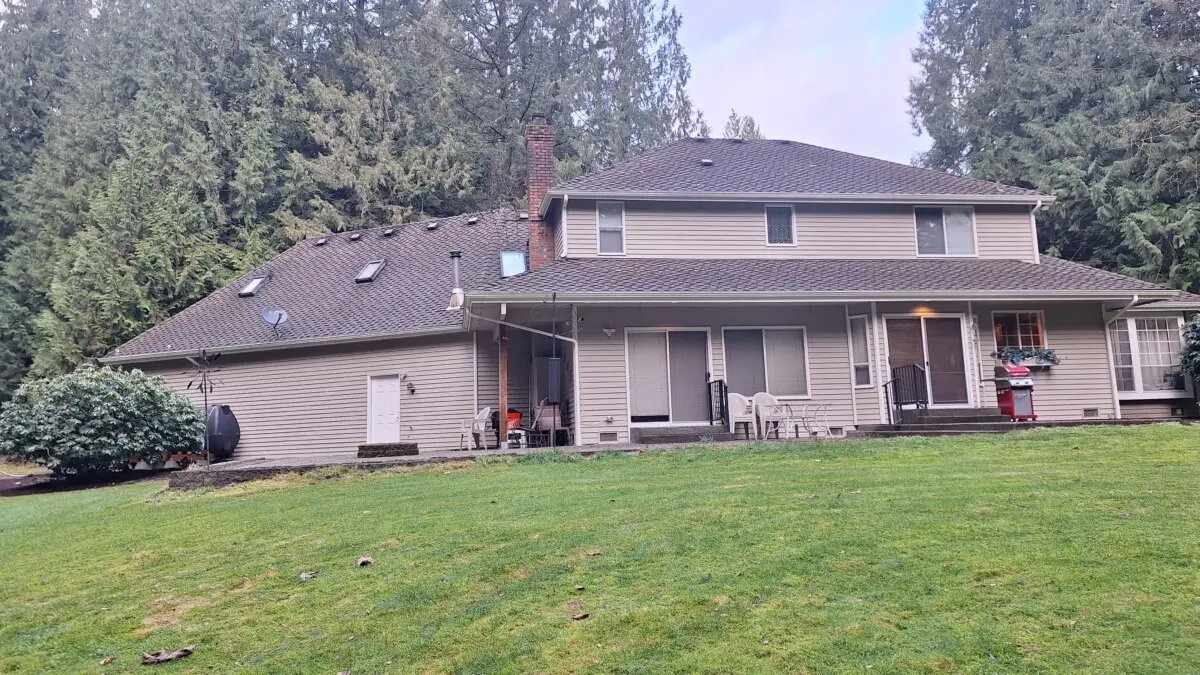
A water source is two downspouts on the west side of the house. These two downspouts redirect rainwater from 35% of the roof area accounting for 750 square feet. This design will allow us to prepare for low moderate and heavy rainfalls year round, creating system that is continually refilling.
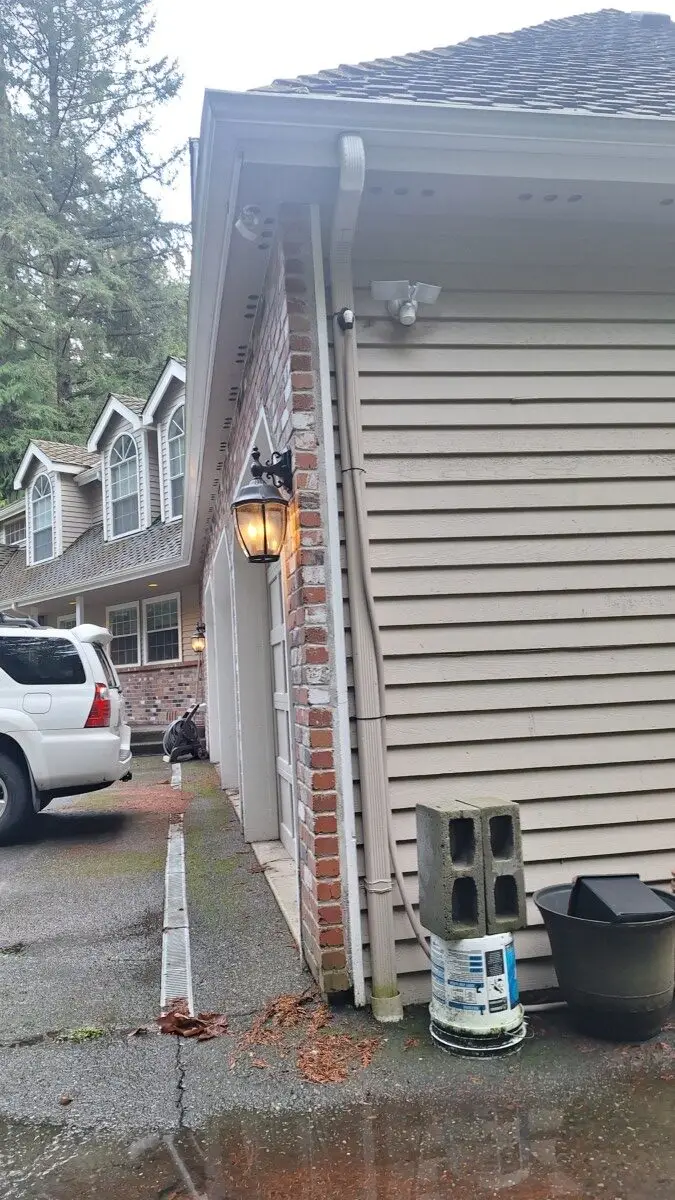
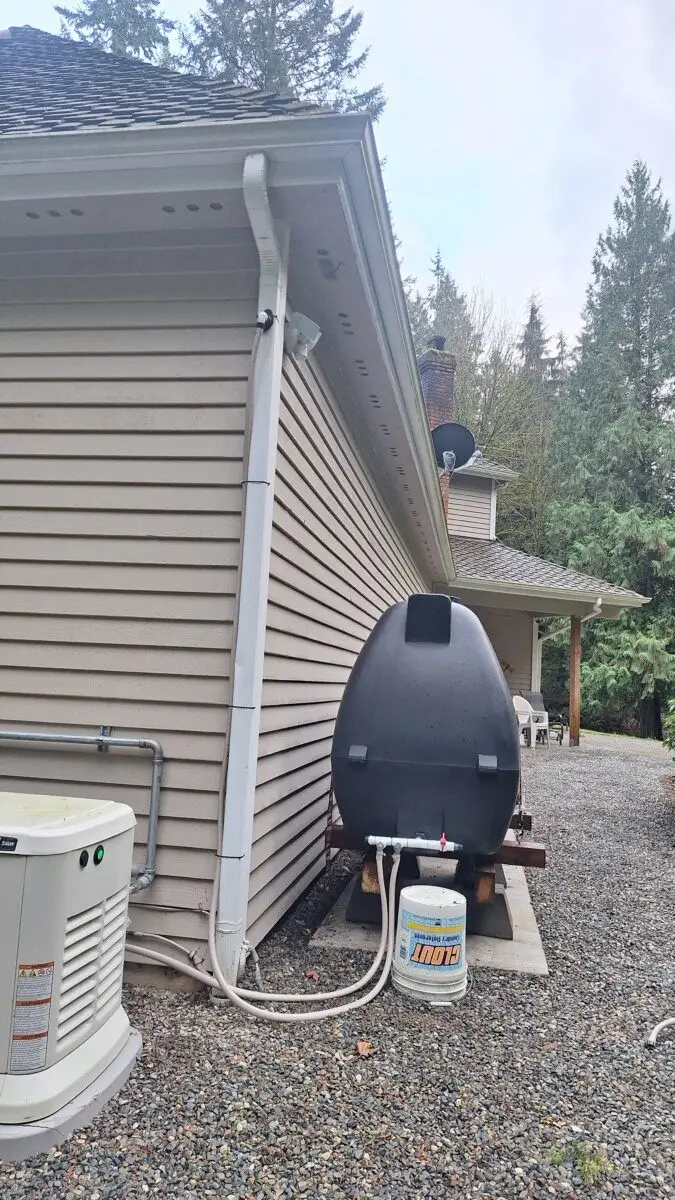
👈 On the left, witness the versatility of our design. The Deviator connects to our delivery system – in this case, a simple garden hose. This hose runs at ground level behind the garage, linking to our rain tank. It’s proof that effective water management doesn’t always require complex infrastructure!
👉 To the right, we showcase a more direct approach. This Deviator has a shorter span, connecting straight to the rain tank. It’s efficiency at its finest!
🌿 The beauty of this horizontal rainwater redirection method? Flexibility! We can now place our rain tanks wherever we choose, adapting to any landscape or architectural challenge.
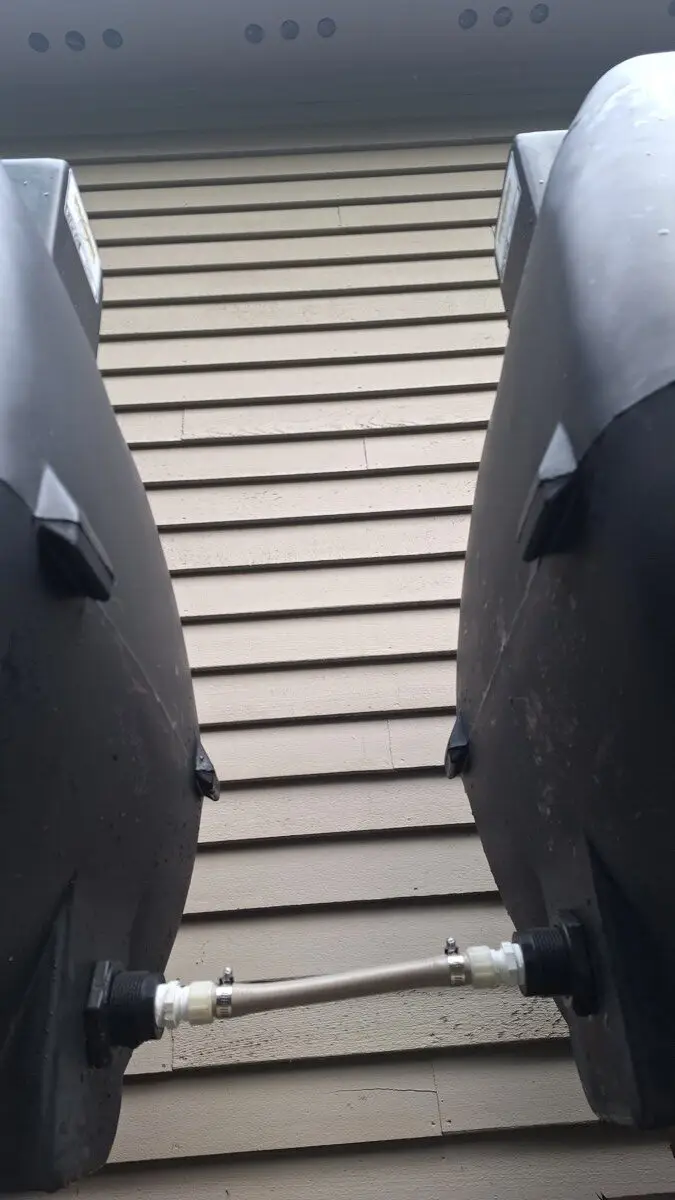
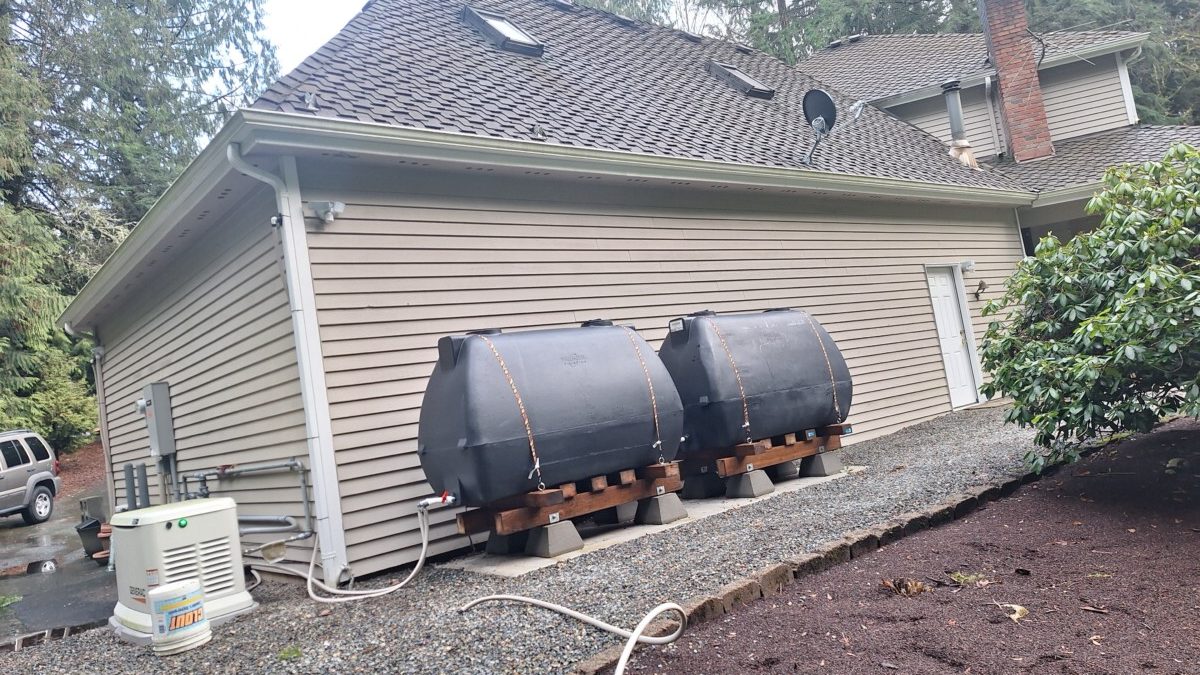
Left side magic: We’ve linked two tanks to create one massive 950-gallon reservoir! It’s like giving your property a water superpower. Both tanks fill simultaneously, working in perfect harmony to maximize every drop.
🏗️ Right side brilliance: Feast your eyes on our elevated platform masterpiece! We’ve engineered a rock-solid foundation using 4×4 sections on pavers, all resting on a concrete path. It’s not just sturdy – it’s smart!🚀
Those 2 feet of elevation? They’re the secret sauce! This height generates just enough static pressure to power low-pressure drip irrigation. Your garden will thrive with a gentle, efficient watering system that works like a dream.
Here’s a table comparing traditional rainwater vertical collection methods with Product Water’s innovative approach:
| Aspect | Traditional Vertical Collection | Product Water’s Innovative Approach |
|---|---|---|
| Collection Method | Primarily uses gutters and downspouts on roofs | Utilizes non-vertical collection techniques, including the Deviator gutter insert |
| Storage Location | Often limited to areas near downspouts | Allows for flexible tank placement, even away from the collection surface |
| System Type | Typically “dry” systems with direct top-fill tanks | Incorporates “wet” systems with underground piping for multiple collection points |
| Efficiency | May lose water during heavy rainfall due to overflow | Maximizes capture efficiency by collecting water in multiple directions |
| Aesthetics | Can involve large, visible storage tanks | Uses smaller, unobtrusive collectors feeding into hidden storage |
| Adaptability | Often requires significant roof modifications | Can be retrofitted to existing roof designs and downspouts |
| Water Management | Basic collection and storage | Incorporates advanced regulation and low-pressure irrigation systems |
| Environmental Impact | Reduces reliance on municipal water | Further reduces energy costs associated with treated water |
This table highlights the key differences between traditional vertical rainwater collection methods and Product Water’s innovative approach, showcasing the company’s advancements in efficiency, flexibility, and sustainability.
The AP 15300ST blends technical precision and sophisticated aesthetics. Its 39-millimeter stainless steel case provides a contemporary fit, achieving harmony between prominence and comfort. The signature eight-sided bezel, secured by hexagonal fasteners, exemplifies the brand’s revolutionary approach to luxury sports watches.
Showcasing a luminescent-coated Royal Oak hands dial, this model integrates a 60-hour energy reserve via the automatic caliber. The intricate guilloché motif adds dimension and uniqueness, while the streamlined construction ensures discreet luxury.
The AP 15300 st blends meticulous craftsmanship and sophisticated aesthetics. Its 39mm stainless steel case guarantees a modern fit, striking a balance between presence and wearability. The signature eight-sided bezel, secured by eight hexagonal screws, defines the brand’s innovative approach to luxury sports watches.
https://graph.org/Audemars-Piguet-Royal-Oak-15300ST-Unveiling-the-Steel-Icon-06-02
Showcasing a applied white gold indices dial, this model incorporates a 60-hour power reserve via the automatic caliber. The intricate guilloché motif adds depth and uniqueness, while the streamlined construction ensures understated elegance.
Audemars Piguet’s Royal Oak 15450ST boasts a
slim 9.8mm profile and 5 ATM water resistance, blending luxury craftsmanship
Its silvery-grey Grande Tapisserie dial includes applied 18k white gold markers and a scratch-resistant sapphire crystal, ensuring legibility and resilience.
The selfwinding mechanism ensures seamless functionality, a hallmark of Audemars Piguet’s engineering.
Introduced in 2012, the 15450ST complements the larger 41mm 15400 model, catering to slimmer wrists.
The recent 2019 iteration highlights meticulous craftsmanship, appealing to collectors.
https://www.tumblr.com/sneakerizer/784512797388292096/audemars-piguet-royal-oak-15450st-the-quiet
The dial showcases a black Grande Tapisserie pattern highlighted by luminous appliqués for effortless legibility.
A seamless steel link bracelet ensures comfort and durability, fastened via a signature deployant buckle.
A symbol of timeless sophistication, it continues to captivate collectors in the world of haute horology.
The Audemars Piguet Royal Oak 15450ST features a
37mm stainless steel case with an iconic octagonal bezel, creating a elegant silhouette.
Its silvery-grey Grande Tapisserie dial includes luminescent hour markers and a scratch-resistant sapphire crystal, ensuring legibility and resilience.
The selfwinding mechanism ensures seamless functionality, a hallmark of Audemars Piguet’s engineering.
Introduced in 2012, the 15450ST complements the larger 41mm 15400 model, catering to classic proportions.
Available in multiple color options like blue and white, it suits diverse tastes while retaining the collection’s iconic DNA.
Audemars 15450 st
The dial showcases a black Grande Tapisserie pattern accented with glowing indices for clear visibility.
The stainless steel bracelet combines elegance with resilience, secured by a hidden clasp.
Celebrated for its high recognition value, this model remains a top choice among luxury watch enthusiasts.
The Audemars Piguet Royal Oak 16202ST features a elegant stainless steel 39mm case with an extra-thin design of just 8.1mm thickness, housing the latest selfwinding Calibre 7121. Its striking “Bleu nuit nuage 50” dial showcases a signature Petite Tapisserie pattern, fading from golden hues to deep black edges for a captivating aesthetic. The iconic eight-screw octagonal bezel pays homage to the original 1972 design, while the glareproofed sapphire crystal ensures optimal legibility.
https://linktr.ee/apro15202stwow
Water-resistant to 50 meters, this “Jumbo” model balances robust performance with sophisticated elegance, paired with a steel link strap and reliable folding buckle. A modern tribute to horological heritage, the 16202ST embodies Audemars Piguet’s craftsmanship through its precision engineering and timeless Royal Oak DNA.
The Audemars Piguet Royal Oak 16202ST features a elegant stainless steel 39mm case with an extra-thin design of just 8.1mm thickness, housing the advanced Calibre 7121 movement. Its striking “Bleu nuit nuage 50” dial showcases a intricate galvanic textured finish, fading from a radiant center to dark periphery for a dynamic aesthetic. The octagonal bezel with hexagonal screws pays homage to the original 1972 design, while the scratch-resistant sapphire glass ensures clear visibility.
https://graph.org/Audemars-Piguet-Royal-Oak-16202st-The-Stainless-Steel-Revolution-06-02
Water-resistant to 5 ATM, this “Jumbo” model balances sporty durability with sophisticated elegance, paired with a steel link strap and secure AP folding clasp. A contemporary celebration of classic design, the 16202ST embodies Audemars Piguet’s craftsmanship through its precision engineering and evergreen Royal Oak DNA.
¿Necesitas códigos promocionales exclusivos de 1xBet? Aquí encontrarás bonificaciones únicas para tus jugadas.
La clave 1x_12121 garantiza a 6500 RUB al registrarte .
Para completar, canjea 1XRUN200 y obtén un bono máximo de 32500 rublos .
https://brightbookmarks.com/story19852452/activa-tu-c%C3%B3digo-promocional-1xbet-y-gana-en-grande
Mantente atento las ofertas diarias para conseguir ventajas exclusivas.
Los promocódigos listados están actualizados para hoy .
Actúa ahora y maximiza tus oportunidades con esta plataforma confiable!
¿Quieres cupones vigentes de 1xBet? Aquí podrás obtener las mejores ofertas en apuestas deportivas .
El promocódigo 1x_12121 ofrece a un bono de 6500 rublos para nuevos usuarios.
Además , activa 1XRUN200 y recibe una oferta exclusiva de €1500 + 150 giros gratis.
https://deanfqai29741.iyublog.com/34494362/descubre-cómo-usar-el-código-promocional-1xbet-para-apostar-free-of-charge-en-argentina-méxico-chile-y-más
No te pierdas las ofertas diarias para acumular recompensas adicionales .
Los promocódigos listados funcionan al 100% para esta semana.
Actúa ahora y potencia tus oportunidades con la casa de apuestas líder !
На данном сайте вы можете найти боту “Глаз Бога” , который позволяет проанализировать всю информацию о любом человеке из общедоступных баз .
Этот мощный инструмент осуществляет анализ фото и раскрывает данные из соцсетей .
С его помощью можно узнать контакты через официальный сервис , используя фотографию в качестве поискового запроса .
пробив по базе данных
Система “Глаз Бога” автоматически обрабатывает информацию из множества источников , формируя подробный отчет .
Клиенты бота получают ограниченное тестирование для тестирования возможностей .
Решение постоянно развивается, сохраняя высокую точность в соответствии с законодательством РФ.
Здесь вы можете отыскать боту “Глаз Бога” , который позволяет проанализировать всю информацию о любом человеке из общедоступных баз .
Этот мощный инструмент осуществляет проверку ФИО и раскрывает данные из соцсетей .
С его помощью можно проверить личность через Telegram-бот , используя автомобильный номер в качестве ключевого параметра.
проверка владельца машины
Алгоритм “Глаз Бога” автоматически анализирует информацию из множества источников , формируя структурированные данные .
Пользователи бота получают ограниченное тестирование для ознакомления с функционалом .
Платформа постоянно развивается, сохраняя актуальность данных в соответствии с стандартами безопасности .
© 2025 Product Water. All Rights Reserved
Leave a Reply